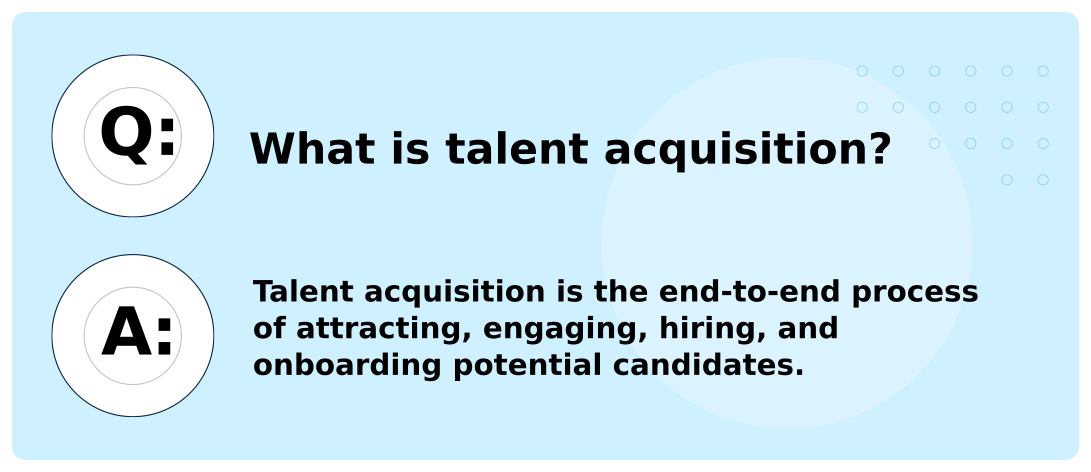
As a business person, you know that structure is the platform for creating more efficient and effective processes. When it comes to talent acquisition strategies it’s important to not only develop a great strategy, but to develop a talent acquisition framework to go along with the strategy that allows you to scale the strategy. Building an effective talent acquisition strategy requires a framework to get qualified candidates across your whole organization.

What is talent acquisition?
Talent acquisition is the end-to-end process of attracting, engaging, hiring, and onboarding potential candidates. Talent acquisition strategies leverage employer branding, company culture, social media, and job descriptions in alignment with the company stakeholders to attract top talent. Strategic talent acquisition is a holistic recruitment process and structure to continually attract the best talent for your company. This process should be scalable for hiring managers as your company grows.
Talent acquisition strategy framework
A talent acquisition framework is an internal tool that provides structure to hiring for any type of job vacancy within your company. In other words, it is a strategic talent acquisition roadmap to bringing in qualified candidates from the talent pool.
The next question for hiring in your small business becomes, “how do I write a talent acquisition strategy framework?” Here are 7 questions to help build a strong talent acquisition strategy template:
- What is our employer branding? This should include company culture, business goals, initiatives, philanthropy, company perks, remote work vs. office work, etc. Employer branding should paint a clear picture to job seekers about what your company does, what it values, and who works there. Employer branding also needs to be consistent across different positions and external media.
- What is the budget for the position? This question encompasses salary, expected time for the HR department, extra hiring process costs (i.e. a candidate lunch), and the cost of any sponsored job postings.
- Where will the job be posted? Companies should strategize how to navigate job boards, career pages, employee referrals, social media, etc. Online job boards such as LinkedIn or Glassdoor are becoming increasingly popular for job seekers to find job openings. However, these websites also require well-written job descriptions so that the top candidates are able to find your job openings when they search.
- What constitutes a qualified candidate? This is an important question to ask all stakeholders for a given position. The answer to these questions helps inform hiring decisions about who would make the best employees. Qualified candidates do not have to have all the necessary skill sets, but there should be a threshold for the amount of training new employees need to be successful at their job.
- How will we engage qualified candidates? This question is meant to answer how the recruitment process will work after an application. The interviews, phone screens, emails, etc. should be structured in a scalable manner.
- Who will manage the hiring process? Every small business has different managers for hiring. Some business owners own the process themselves until their business grows too large. Many use an HR team or hiring managers. Another option is to outsource the hiring process to a recruiting company or an outsourced HR firm.
- How will data be used? Analytics should also drive your talent acquisition strategy. It can help improve the candidate experience, attract better talent, and drive down costs. When building your talent acquisition framework, plan to collect data throughout the process.
Click here to download these questions in our talent acquisition strategy framework pdf
Key elements of a modern talent acquisition strategy for small business
Businesses without talent acquisition plans are struggling to stay afloat in the current battle for talent retention and new hires. Even more businesses have limited talent acquisition strategies that only help fill open positions in the short term. These strategies include inflating salaries or large signing bonuses. An effective talent acquisition strategy is modern and end-to-end. Here are the key elements of a modern talent acquisition strategy for small businesses:
- Metrics and Feedback- Data informs better decisions. Small businesses may feel as if they do not hire frequently enough to collect meaningful data. However, one recruiting process can provide many informative metrics. Breaking down numbers about candidate sourcing, resumes, the number of qualified candidates, time to fill, total cost, etc. can create better decisions for your next open position. These metrics can tweak your framework, communication, hiring process, and time allocation. Seeking feedback from potential candidates helps give insight into the candidate experience during the hiring process. Candidates frequently have very different perspectives than the hiring managers. This anecdotal information breeds better habits and awareness when engaging with candidates.
- Personalization- Small businesses have an advantage over large corporations with their ability to personalize the recruitment process. Automation and applicant tracking systems can be necessary for both small and large businesses. Small businesses can build personal touches into their talent acquisition framework that will resonate with the best candidates. A personal message from the CEO, an interview with their future boss, or just a routine check-in on candidates after an application can go a long way for that candidate and the reputation of your company.
Clear Expectations- Job seekers want to know about the job and company they are walking into. Well-written job descriptions are the first step in this process. These descriptions will showcase the role, employer branding, and company culture. Potential candidates are attracted to honesty and the ability to envision their future at your company. This also helps talent management on the back-end because it improves retention as well. The modern talent acquisition process should attract qualified candidates because they understand what their job will be and the company they will be working for.
Contact us to begin a partnership to create meaningful change for your business.
Related Content

Startup Employee Benefits – Compensation and Health Benefits for Startup Companies
At its core, your startup or small business should include the following benefits: Health Insurance (vision and dental), paid time ...

How To Pay Employees in a Startup
At a fundamental level, HR management includes any tasks that help optimize your most valuable resource—your people!

What Are the 4 Fundamentals of HR?
At a fundamental level, HR management includes any tasks that help optimize your most valuable resource—your people!
Stay in the know